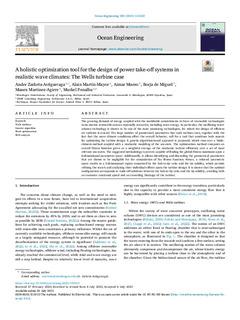Izenburua
A holistic optimization tool for the design of power take-off systems in realistic wave climates: The Wells turbine caseBeste instituzio
IkerbasqueIDOM
Bertsioa
Bertsio argitaratua
Eskubideak
© 2023 The AuthorsSarbidea
Sarbide irekiaArgitaratzailearen bertsioa
https://doi.org/10.1016/j.oceaneng.2023.115332Non argitaratua
Ocean Engineering Vol. 285. Parte 2. N. art. 115332Argitaratzailea
ElsevierGako-hitzak
Wells turbines
Genetic algorithm
Blade optimization
BEM analysis ... [+]
Genetic algorithm
Blade optimization
BEM analysis ... [+]
Wells turbines
Genetic algorithm
Blade optimization
BEM analysis
ODS 7 Energía asequible y no contaminante
ODS 12 Producción y consumo responsables
ODS 13 Acción por el clima [-]
Genetic algorithm
Blade optimization
BEM analysis
ODS 7 Energía asequible y no contaminante
ODS 12 Producción y consumo responsables
ODS 13 Acción por el clima [-]
Laburpena
The growing demand of energy coupled with the worldwide commitments in favor of renewable technologies turns marine renewable sources especially attractive, including wave energy. In particular, the o ... [+]
The growing demand of energy coupled with the worldwide commitments in favor of renewable technologies turns marine renewable sources especially attractive, including wave energy. In particular, the oscillating water column technology is shown to be one of the most promising technologies, for which the design of efficient air turbines is crucial. The large number of geometrical parameters that such turbines own, together with the fact that the wave climate conditions affect the overall behavior, call for a tool that combines both aspects for optimizing the turbine design. A genetic-algorithm-based approach is proposed, which runs over a blade-element-method coupled with a stochastic modeling of the sea-state. The optimization method computes an overall fitness function given as a weighted average of the stochastic turbine efficiency over a set of most relevant sea-states. The suggested methodology is proven capable of finding the global fitness maximum upon a 6-dimensional parametric space. Additionally, it allows identifying and discarding the geometrical parameters that are shown to be negligible for the computation of the fitness function. Hence, a reduced parametric space results in a 2-dimensional region comprised by the hub-to-tip ratio and the tip solidity, which permits refining the search and analyzing their individual effects upon the turbine design. It is shown that the optimal configuration corresponds to trade-off solutions between the hub-to-tip ratio and the tip solidity, avoiding both an excessive rotational speed and an exceeding blockage of the turbine. [-]
Bildumak
Item honek honako baimen-fitxategi hauek dauzka asoziatuta:























